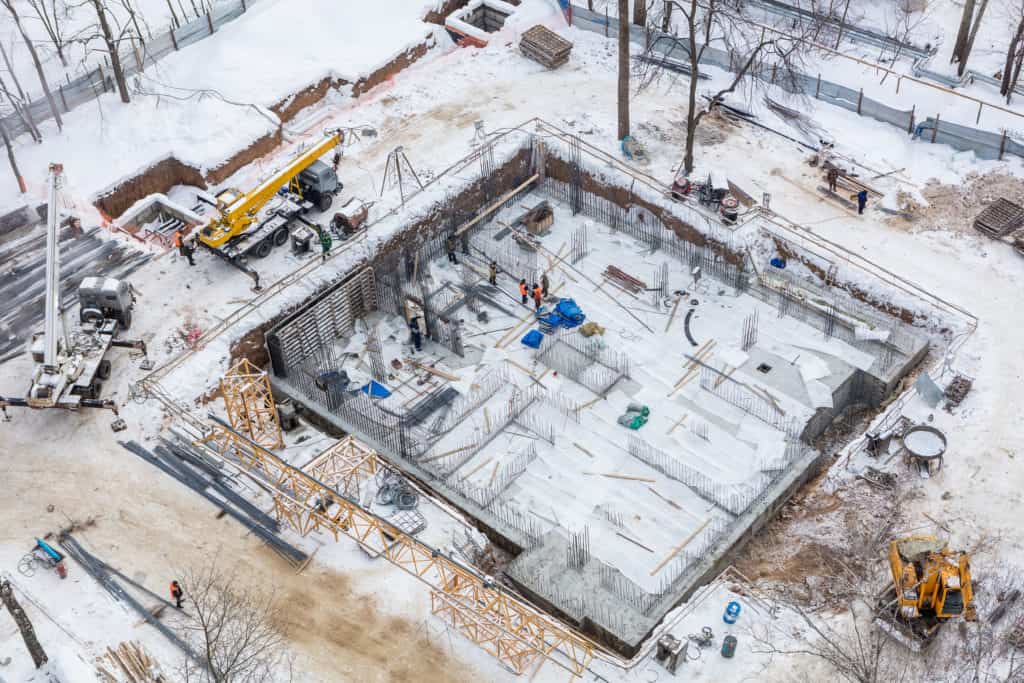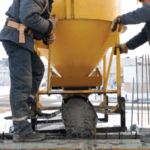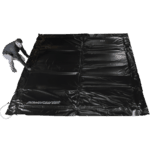Concrete has many advantages over other building materials. It is low maintenance, durable, and forms the foundations of our man-made world. In order to enjoy the strength and versatility of concrete year-round, extra precautions must be undertaken.
Why are Cold Climates a Problem for Concrete?
Cold weather presents a slew of concrete complications.
Frozen Ground
During cold weather, there are additional steps in the concrete pouring process when the ground has frozen. Manpower, time, and resources must first be diverted to ground thawing to ensure concrete is not poured onto frozen ground. The hydration process of concrete curing is an exothermic process and does generate some heat. However, the little heat that is generated will be quickly lost into the frozen ground, and the concrete will not stay warm enough to achieve a strong cure. Frozen ground will also settle when it thaws, causing the slab to shift and crack.
Excess Moisture
Standing water due to snow and ice melt are common on building sites during the winter. Pouring concrete onto soggy ground introduces excess moisture into the mixture which affects cure duration and compressive strength.
Slow to No Cure
For starters, concrete curing time is always longer when the weather is cold. If temperatures fall below 50° F, the curing process slows dramatically. If temperatures fall below 40° F, the hydration reaction essentially stops and the concrete will not cure to the needed strength requirements. Since concrete is mostly poured during the early stages of a building project, these delays can be costly.
Freezing Defects
There are also a number of concrete defects that are caused by cold temperatures. Concrete should not be allowed to enter a freeze cycle during the first 24 hours after it has been poured. The early formation of ice crystals jeopardizes concrete strength and will result in spalling, pop-outs, and uncontrolled cracking.
Exposed Transportation
Even if concrete is mixed with warm water at the plant, it will continually lose heat as it is being transported. According to Bergen Mobile Concrete, during winter conditions, concrete can lose 5 degrees or more every hour it is on the road.
Tips For Cold Weather Concreting
Planning can help you protect your concrete throughout the preparation, pouring, and curing stages.
Prep The Ground
For faster and more thorough curing, use ground thawing blankets to prepare the ground before pouring. This will help your concrete cure evenly. As snow and ice melt, ensure your pour site has a minimum slope of ¼ inch per linear foot to drain excess water.
Go Easy on the Water
The more water you add when you mix, the longer it will take to cure. While adding water to concrete makes it easier to pour, it can also weaken the concrete and prevent chemical reactions from finishing. Maintaining a low water to cement ratio prevents the water from icing up in freezing conditions.
Refine Your Slump Test
The slump test measures the consistency of fresh concrete. A concrete mixture is poured into a cone and turned over. The cone is removed and the tester measures how far the mixture slumps down. The lower the number the stiffer concrete is. Different concrete uses require different consistencies. During winter conditions, concrete mixtures should be stiff enough to slump 4 inches or less.
Use a Wintry Mix
Wintry mixes include useful ingredients to help your concrete cure and set properly despite cold conditions. Wintry mixes include accelerators to speed up curing and water reducing additives. These mixtures often have more binding cement powder as well to create a stronger cold mix.
Protect Your Cure
In order to ensure your concrete has cured to the required compression strength, your concrete needs to stay protected and warm during the curing process. Concrete temperatures must stay between 65° and 85° F in order to reach a minimum strength of 500 psi. Once it reaches this compressive strength it will be able to resist the effects of freezing temperatures. The most effective way to protect and warm your concrete is to use concrete blankets after it’s poured.
Stay Up to Date
Keep yourself educated on the continuously advancing world of concrete so you are always aware of the best products, practices, and building codes. The ACI ( American Concrete Institute) offers a wide variety of educational seminars and certifications for every career in the concrete industry.
Cold Concreting Solutions From Powerblanket
Powerblanket offers ideal solutions for cold weather concreting. Our ground thaw blankets provide powerful and even heating to efficiently prepare your ground before pouring. Powerblanket concrete blankets cure 2.8 times faster than conventional insulated blankets and protect your slab throughout the hydrating process. They are heavy duty, weather resistant, easy to install, and are ACI compliant for cold weather concreting. Contact us to find the right concrete solution for your needs 801.506.0198 or [email protected].
Concrete Guide
Take a look at our Concrete Guide for Concrete Industry Professionals. Inside you will learn about:
- Aggregates
- Tips for Working with Concrete
- Weather & Concrete
- How to Grow Your Concrete Business
Frequently Asked Questions
What temperature is too cold for concrete?
Concrete should not be poured when temperatures drop below 10°C (50°F) as the chemical reactions needed for setting and strengthening slow significantly, and below freezing, these reactions stop entirely.
What’s the lowest temperature you can lay concrete at?
Concrete work should not proceed if the air temperature drops to 2°C (35.6°F) unless the ground is not frozen and the aggregate temperature is above 2°C.
How long does 4 inches of concrete take to cure in cold weather?
In cold weather, 4-inch-thick concrete typically takes about 28 days to cure, but it must be protected from freezing within the first 24 hours to ensure proper strength development.
What type of concrete is best for cold weather?
For cold weather, a high-quality concrete mix with a minimum compressive strength of 4,000 psi is recommended to resist the effects of expanding water and freezing temperatures.
Cure your concrete faster and better in cold weather conditions with Powerblanket.






